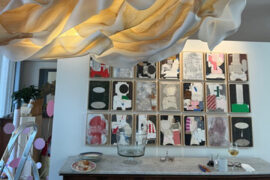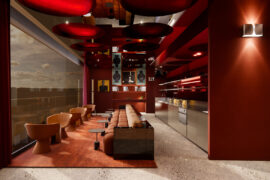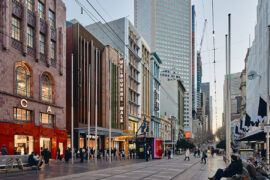Australia has produced some fine ceramicists, but none has achieved the international prominence of Pip Drysdale, which makes her an Indesign Luminary alumni.
Even with an international resurgence of interest in ceramics, Pippin Drysdale is something of a phenomenon – an Australian ceramicist who has built a significant profile in the international arena.
Recognised as a Master of Australian Craft in 2007, Drysdale’s distinctive porcelain vessels, with their arresting colour, subtlety and originality, are held in many major museums and private collections internationally and nationally. Her work is regularly shown at the world’s major art fairs and keenly collected by wealthy patrons, making her the highest earning ceramicist Australia has ever produced.
Approaching Drysdale’s ceramics, however, evokes awe and trepidation. At her May 2014 solo exhibition at Sydney’s Sabbia Gallery, a number of tall pots stood alone on their plinths, with other works arranged in groups, from two or three up to large extended families of forms. Most were vessels, some were closed forms, but all stood on small, fate-tempting bases. You imagine a loud noise would topple them, or a sudden breath of wind would have them in pieces.
But stand they do, in what has been called a delicate balancing act – they are much heavier in the base than their fine rims would indicate – radiating their often dazzling, highly saturated colours and creating a simultaneous sense of composure and tension.
As Perth-based art critic, David Bromfield puts it: “To contemplate them is an extraordinarily moving visual experience, a moment in which one recovers a sense of universal harmony, absolutely free of clichés.”
While the interiors are usually filled with a single rich gradated hue, across the outside surfaces patterns of fine lines meander, falter and collide, marking out their terrain. Many of the vessels are glazed in the brilliant red, orange and rust tones of the deserts of North-Western Australia, which provided their initial inspiration.
For over ten years now Drysdale has made works in response to these landscapes – Tanami Traces, then Tanami Mapping, now in its third series – each new body of work reinforcing its connection to this unmistakably Australian imagery. Drysdale’s arrival at the restrained clarity of these works has marked a definitive stage in her career, although she has almost always used the landscapes she has experienced, at home or abroad, as creative springboards.
Born in 1943, Pippin Carew-Reid grew up, the eldest of four siblings, in highly privileged circumstances in Perth. Her father, a successful businessman and entrepreneur, “was always a big picture man and, of course, he gave me big picture thinking”. She already had her own big personality to go with it. A gung-ho character with an explosive laugh, a boots-and-all attitude and a roller-coaster history, Pippin was always interested in art and colour. She married Christopher Drysdale, second cousin of painter, Russell Drysdale, in 1967, and following the birth of son Jason, the couple separated in 1972.
After two business ventures and another relationship, she found herself in her early thirties with a potter’s wheel and a kiln and decided she would learn to make pots. “I just loved the feeling of making things with clay. I loved the challenge.”
She studied ceramics at Perth Technical College, although a residency at Anderson Ranch Arts Centre, Colorado, was particularly formative. “There were all these amazing potters,” including Paul Soldner, Toshiko Takaezu (who became her friend and mentor) and author, educator and ceramic artist, Daniel Rhodes, who offered her great encouragement.
On his advice she returned to Australia and, with the help of arts academic, author and family friend Ted Snell, she enrolled at Curtin University to do a BA in ceramics.
Drysdale had been throwing bowls, but at this time she made slab plates, using the surfaces as canvases for expressionistic drawing. She used coloured slips (liquid clays), glazes, and resists such as masking tape and latex to create imagery by layering often-spontaneous mark-making, (Window series, 1986.)
She cites Willem de Kooning as an influence, but also says “I just wanted to work with colour, colour, colour.” Over the next few years, she produced series after series, motivated by the landscapes around her and environmental concerns – for example, the Treescape (1989) and Logging on Parchment series (1990). By this time her work was being selected for national exhibitions, and she began teaching and giving workshops around Australia.
In the early 1990s, Drysdale abandoned the slab plates, but continued her spontaneous style of decoration on her wheel-thrown pots. “I love pure form. I’ve never wanted to be complicated with form because I love to be extravagant with the surface.” She did residencies in Wales, Italy, Russia and the USA.
In Italy, she learned the majolica technique of decorating on (unfired) glaze, and the use of lustres, a process in which a thin film of light-diffusing metal is fused to the ceramic surface after glazing (Totem and Carnivale series). An Australia Council grant, one of many she received over the years, allowed Drysdale to pursue lustres here, and from her Russian experience she produced the aptly named Over The Top series, exuberant works in which gold and platinum lustres were put to opulent effect.
She also travelled in Western Australia, producing the Landscape Lustre (1994), Pinnacles (1995) and the rich and evocative Eastern Goldfields series, which was praised by New Zealand art critic, Howard Williams, for “distilling an expression descriptive of Australia without resort to the obvious symbols of flora or fauna”. Around this time she also began collaborating with master potter, Warwick Palmateer, who threw the vessels for her, allowing her to focus on decoration.
Drysdale’s freewheeling spontaneity and masterly use of glazes and lustres reached its peak after a trip to Pakistan. “Those pots from the Pakistan series were phenomenal because I literally poured glazes all over them, then poured paraffin wax all over and then gashed back and filled, gashed back and filled, there were loads of layers. I just worked with my own intuitive madness at the time.” It is easy to see these works as a direct expression of her larger-than-life persona.
After exhibiting the Pakistan series at Quadrivium in Sydney in 2000, she included some pieces in a group show, Australian Contemporary Ceramics, which gallery-owner, Marianne Heller, had organised in Heidelberg, Germany. Heller then offered Drysdale a solo show there, a major opportunity, and one that led Drysdale to re-think her practice.
Because of the toxicity and firing hazards inherent in their use, Drysdale abandoned the waxes and lustres, and found and perfected a (safer) new resist medium (Liquitex) that lent itself to much more controlled and sensitive linework. She also took a strategic view of the German market.
“They’re intense, they’re restrained, they’re minimal, they’re subtle – they’re everything I’m not!” A feeling of Australianness was another “very intentional” objective for the new work, and again her travels provided her direction.
In 1998, on a Creative Development Fellowship from ArtsWA, Drysdale had flown with a small group of art collectors to visit remote Aboriginal communities in northern Australia. “That particular trip is still what inspires me today,” she says. “When you’re flying low out in the Great Sandy Desert or the Tanami Desert, you’ve got this infinity of shadow and line and ripples, shadow and light.
Subconsciously, I was very influenced by indigenous painting, and when I did that journey it reinforced that aerial sense,” she says, citing painter, Fred Williams, as an influence for the same reason. After much experimentation back in her Fremantle studio, Drysdale arrived at the fusion of intense colour, fine linework and technical precision that became the first Tanami series.
The exhibition, Red Desert, was to be shown at Galerie Marianne Heller, in Heidelberg in 2003. But, due to a fire, it was transferred to the prestigious MAK Museum in Frankfurt, where it was a spectacular success. As Heller wrote in the catalogue: ‘”…the serenity and calmness radiated by Pippin’s vessels almost seem like a force from another planet”.
Certainly Drysdale’s career took a stellar turn as a result, with acquisitions by major international museums, invitations to exhibit, accolades and sales. It is a trajectory that has continued for over ten years, as Drysdale has continued to draw on the landscapes and flora of northern Australia, from the deserts to the Kimberley.
While the restraint in Drysdale’s work since Red Desert represents a radical departure from her earlier work, her practice (despite its earlier vigour and spontaneity) has always maintained a rigorous approach to the materials and processes of her craft.
“Everything is meticulous,” she says, and in a state of continual refinement. Far from being a sole operator, Drysdale’s production is something of a small industry.
She is assisted in the studio by a small, dedicated part-time team who assist with glaze mixing, firing, colour testing, sanding of bisque-ware, website and computer work, and packing and despatch of the work to shows. Drysdale values the input of all concerned. She is also grateful to the many people who have contributed to her success.
Ted Snell has been a significant supporter over many years, arranging a major retrospective for her, Lines of Site at John Curtin Gallery, Perth, in 2007. “Ted Snell has probably been one of the best catalysts in my life,” says Drysdale.
Gallerists such as Marianne Heller and Anna Grigson, of Quadrivium and Sabbia have also been instrumental, along with her dealers in London, Joanna Bird, and Adrian Sassoon in particular, who takes her work to the world’s major art fairs: Maastricht Art Fair, Holland, and Masterpiece, PAD, and COLLECT in London and The Salon: Art + Design in New York. These dealers have contacts with collectors who buy her work, although Drysdale has always been well-connected in her own right, and a canny marketer and self-promoter.
She recalls how she used to invite groups of wealthy WA collectors around to her studio “to get the first bite of the cherry” before a body of work was sent to a show. “I’d have all these pots on shelves and I’d give them each one of these torch-lights, it was hilarious! We’d go round and look at every piece and by the end of the evening I would have sold $20,000 or $30,000 worth of pots.”
“I’m probably the luckiest ceramic artist in the world. I’ve worked hard. But to have had the passion [to do] something I really love, and to have so much gratification around the world for my work is amazing. My Dad would have been proud of me. It’s taken a long time, a good 40 years. But you’ve got to do your time, and I’ve been very fortunate to have [had] all the time in the world.”
Pip Drysdale was featured as an Indesign Luminary in issue #56 of Indesign magazine.
Pippin Drysdale and Warwick Palmateer are doing a major collaborative exhibition at John Curtain Gallery in September 2018.
–
Get more stories like this straight to your inbox. Sign up for our newsletter.
INDESIGN is on instagram
Follow @indesignlive
A searchable and comprehensive guide for specifying leading products and their suppliers
Keep up to date with the latest and greatest from our industry BFF's!

Rising above the new Sydney Metro Gadigal Station on Pitt Street, Investa’s Parkline Place is redefining the office property aesthetic.

London-based design duo Raw Edges have joined forces with Established & Sons and Tongue & Groove to introduce Wall to Wall – a hand-stained, “living collection” that transforms parquet flooring into a canvas of colour, pattern, and possibility.

Held in a private Melbourne residence, Fletcher Arts’ annual exhibition unites over 30 Australian artists and designers in a setting where art meets architecture.

As a UNESCO Creative City of Craft and Folk Art, Ballarat is hosting Craft Lab and The Great Takeaway this month. Nicole Durling, Executive Director at Craft Victoria, tells us more.
The internet never sleeps! Here's the stuff you might have missed

COX Architecture uses saturated colour and hotel-style amenity across the historic St Peters location, designed for Coronation Property.

Buchan weaves heritage and contemporary retail across a 3,600sqm site featuring dual-branded hotels, arcades and revitalised laneways.